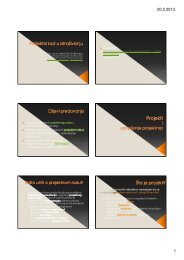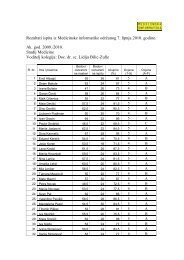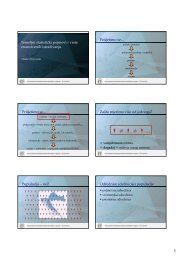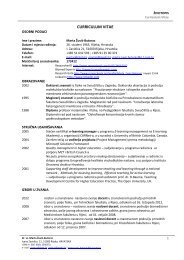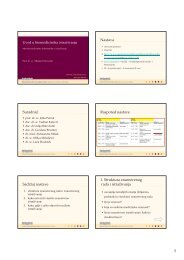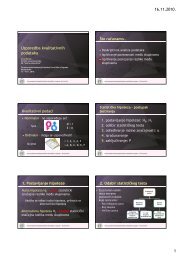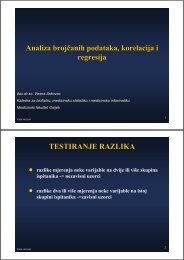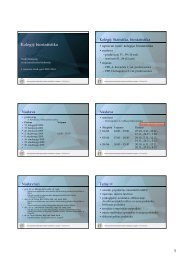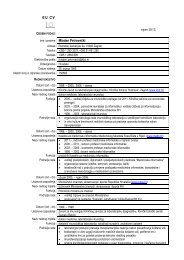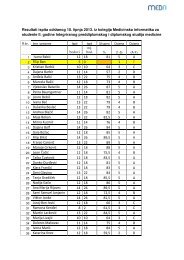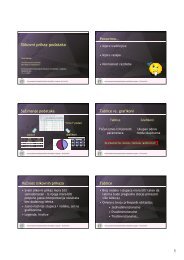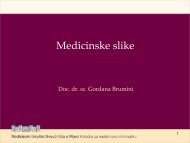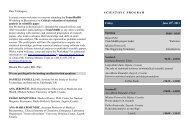1. Typing error 2. Logic, reasoning Logic of scientific work ... - medri
1. Typing error 2. Logic, reasoning Logic of scientific work ... - medri
1. Typing error 2. Logic, reasoning Logic of scientific work ... - medri
Create successful ePaper yourself
Turn your PDF publications into a flip-book with our unique Google optimized e-Paper software.
<strong>Logic</strong>al Principles <strong>of</strong> Reserch inMedicine with Most Common Errors<strong>1.</strong> <strong>Typing</strong> <strong>error</strong><strong>Logic</strong>al Principles <strong>of</strong> Research inMedicine with Most Common ErrorsFrom Idea to Publicationa ☺Pr<strong>of</strong>. Mladen Petrovečki, MD, PhDPh.D. Programe Biomedicine & Health ScienceZagreb University School <strong>of</strong> Medicine2010/11<strong>2.</strong> <strong>Logic</strong>, <strong>reasoning</strong><strong>Logic</strong> <strong>of</strong> <strong>scientific</strong> <strong>work</strong><strong>1.</strong> rules <strong>of</strong> logic and logic itself as a way <strong>of</strong> validthinking is more expressed in science andphilosophy compared to other humanactivities…<strong>2.</strong> science is recognized by utilizing empiricalmethods and therefore logic is prerequisite in<strong>scientific</strong> methodology...www.glasbergen.com/Mirko Jakić. Logika. Školska knjiga, Zagreb 2003.<strong>Logic</strong> <strong>of</strong> <strong>scientific</strong> <strong>work</strong>3. use <strong>of</strong> is logic evident in using logical<strong>reasoning</strong>, by using terms such as rules,conclusions, definitions, distributions, proves,etc.4. logic – how our thinking is valid in ourmission to find the truth…3. Non<strong>scientific</strong> procedures• diligence(habit, attitude, manner, believe, momentum)• authority• intuition1
4. Argument, pro<strong>of</strong> 5. <strong>Logic</strong> in science• system• models <strong>of</strong> the system• deterministic• probabilistic• event probability → P(E)0 ≤ P(E) ≤ 16. Probability• mathematical calculation that something, event,will occur• mathematic probability theory• statistics• mathematics• <strong>scientific</strong> methodology• logic, philosophy• <strong>reasoning</strong> about event feasiblenessProbability, calculation• symbol – P• No. <strong>of</strong> expected eventsP =No. <strong>of</strong> all events• values range 0 – 1:• 0 – impossible event• 1 – certain eventProbability, the term• probability• vjerojatnost, mogućnost• possibility• mogućnost, vjerojatnost, izvedivost• likelihood• vjerojatnost, mogućnost• chance• mogućnost, prigoda, slučaj, slučajnost, vjerojatnost, sreća,povoljna prilika• odds• izgled, prednost, vjerojatnost, slučajnost7. Statistics• probability calculation• probabilistic model<strong>of</strong> the system2
Statistical mechanics8. Measuring & 9. Research• Lord Kelvin(1824.-1907.)• James C. Maxwell(183<strong>1.</strong>-79.)• Ludwig Boltzmann(1844.-1906.)• Willard Gibbs(1839.-1903.)populationknowledge about population ≠ ≠ ...variablep = ?10. Variable• all variables in research1<strong>1.</strong> Measuring scalesNOMINAL• as many <strong>of</strong> them• the end <strong>of</strong> research• simple → complex (data)• accuracy (numbers)• measuring scalesORDINALRATIOINTERVAL1<strong>2.</strong> Error13. Populationknowledge on populationpopulationvariableSAMPLINGsystematicincidentalsampleknowlede on samplestatistical dataanalysis3
14. Sample• part <strong>of</strong> population• what? who?• when?• where?• sizeSample• representative• measurable• probabilistic• simple• system• stratified• clusterSample15. Samplingrelatedunrelatedwww.statehousereport.comSamplingMedCalc16. Bias (sampling)4
Bias (sampling)17. Blinding• Bias – systemic sampling <strong>error</strong>• prevalence bias (Neyman)• admittance rate bias (Berkson)• answering rate bias• etc.• single-blind• double-blind• triple-blind• quadruple-blind18. Control group• must have• to be compared with experimental group• Hawthorn effect• research with no control group• subject changes behavior with a knowledge thatis a part <strong>of</strong> experiment• subject feels better with knowledge to be a part <strong>of</strong>experiment19. Hypothesishttp://biology.ucf.edu/~pascencio/images/Hypothesis.jpg20. Statistical hypothesisStatistical hypothesiselemental statementtruth or not (false, lie)hypothesis testing → finding the truthtruth real object stateprobabilistic system:truth → probabilitysignificant any occasion other thataccidentally:probability → level <strong>of</strong> significance5
2<strong>1.</strong> Null-hypothesisNull-hypothesisNo differenceNo difference ≈ Not guilty2<strong>2.</strong> Testing the hypothesisA. null-hypothesisB. statistical testC. level <strong>of</strong> significanceD. statistics calculationE. conclusionA. Hypothesis• null – H 0 – no difference• alternate – H 1 – difference exists• only one can be truthful• only one can be accepted, other will berejectedB. Choosing the test• measuring scales• sample• size• related on unrelated samples• data distribution• parametric• nonparametric• no. <strong>of</strong> variables• etc.23. Statistical testsScale One sample Two Three or morerelated unrelated related unrelatedNominal binomial McNemar Cohranchi-square Fisher chi-sqr.chi-square/Ordinal Kol.-Smirn. Wilcoxon FriedmanMWp/medianMosesKWInterval ...Ratio ...6
C. Level <strong>of</strong> significance24. Statistical <strong>error</strong>s• Pα if defined before statisticsα – probability <strong>of</strong> rejecting H 0 when H 0 = truth• <strong>error</strong> α (type I <strong>error</strong> or false positive <strong>error</strong>)• as less as possible• default values, e.g. P 0,0526. Conclusion (E)• low P low possibility to reject the truth• conclusion:• P < α• low probability that H 0 is true• reject (not accept) null hypothesis• accept alternate hypothesis• statement “...” is truth with P = ...27. Yes & No in statistics• hypothesis = ?• calculation = ?• correct data = ?• all conditions for statisticvalid = ?• no limitations = ?7
Example 1: “Not” in correlation(cont.)yyyxxxN r plinear 118 0,25 0,006logarithm 118 0,43
30. The truthPr<strong>of</strong>. dr. Mladen PetrovečkiDepartment <strong>of</strong> Medical InformaticsRijeka University School <strong>of</strong> Medicinehttp://mi.<strong>medri</strong>.hrDepartment <strong>of</strong> Clinical Laboratory DiagnosisImmunology DivisionDubrava Clinical Hospital, Zagrebwww.kbd.hr/lab mladenp@kbd.hr9



